Upper MF San Joaquin – home of the ultimate grand slam

Directions: Turn off Hwy 395 and head west on Highway 203 (Minaret Summit Road). You must park at the Mammoth Mountain Main Lodge Gondola Building and take a shuttle to go to Agnew Meadows or Reds Meadow between 7:00 am and 7:30 pm. Cost is $7.00 per person. There are some exceptions for campers and you can drive in before 7:00 am but are still under the time restrictions upon your return trip. The road usually opens in mid-June and closes in November depending upon snow. | ||
Notes:Middle Fork of the San Joaquin The Upper section of the Upper MF San Joaquin is from Agnew Meadows to Upper Soda Springs Campground. This area holds hybridized Golden Trout which have migrated from the higher elevation lakes and mated with the resident Rainbows. The section has long riffles with pocket water and deep pools. This section is also within a dense forest with areas of swamps and high rock cliffs, so it takes some time to fish this section. Most of this water is good for dry flies, switching to nymphs for the deeper pools or early in the season when flows are up. There are two bridges that cross the river, one from below Agnew Meadows and the other at Upper Soda Springs Campground. The Middle section of the Upper MF San Joaquin is from Upper Soda Springs to Minaret Falls. The canyon widens in this section and consists of deep pools holding Brown trout in the 12-14″ range. Fishing just above Upper Soda Springs will give you the best chance at a Grand Slam from one location. The Rainbows and Goldens will be in the faster water while the Browns and Brookies will be in the slower flows. Below Soda Springs Campground are additional campsites and this section tends to be heavily used within the summer months. A dry fly with nymph dropper is the preferred method through this section. The Lower section of the Upper MF San Joaquin is from Minaret Falls to Rainbow Falls. This section is a freestone stream holding mostly Browns. Most of this section is fast pocket water but there are a few large pools holding the larger trout. It’s mostly a nymphing areas selecting spots behind rocks but becomes a very good dry fly section in the late summer, early fall. The Upper MF San Joaquin contains numerous hatches. In June through early July, Midges will start and hatch all season. Golden Stones will show up and a PMD hatch comes off in the early evening hours. BWO’s emerge in the Spring through July when the air temperature warms but tend to be more prolific in October. Caddis will show up in the late afternoon during much of the Summer. During late September and through October, the October Caddis appears as well as the Grannom Caddis. Trico’s will show up near late October. Rainbow Falls
Red’s MeadowRed’s Meadow provides a pack station, cabins, cafe, store, and showers to visitors of the area. It was started by Archie and Gladys Mahan in 1934 and named Red’s Meadow after Red Sotcher who homesteaded the area. The road to the meadow was built in 1929 by miners eager for access to mining claims near Minaret Lake. The Tanner Family bought Red’s Meadow from the Mahan’s in 1960 and have owned and operated it since. The family also owns and operates the Agnew Park Station at nearby Agnew Meadows. Red’s Meadow is a stone’s throw from the PCT/JMT and is a popular resting area for through hikers.
Sotcher Lake: Just north of Red’s Meadow, Sotcher Lake is easily accessible from the road and can be float tubed. It holds Browns, Brookies, and Rainbows. The lake is stocked during the summer months but there are also large browns that reside in the lake year round. Formed by glacial erosion, it lies at the western base of Mammoth Mountain. Avalanche debris from the mountain covers the bottom of the lake with trees and rocks, providing excellent cover for the trout. A deep nymphing set-up with midges, damsel and callibaetis patterns are productive in the early morning and evening hours and fishing from a float tube or kayak will be most effective in order to target deeper water. Streamers and wooly buggers can be successful with active fish. A number of nearby lakes can be accessed from trailheads within the area. These lakes are within the Ansel Adams Wilderness, formerly the Minarets Wilderness, named in 1984.
At Agnew Meadows Trailhead (Elevation: 8300 feet) you can access:
Shadow Creek: Fish between Shadow Lake and Ediza Lake. There is about 2.5 miles of freestone stream between the two lakes. The stream consists of pools and runs with some small waterfalls and a slow section through meadows. Contains Rainbows and Brookies in the 6-8 inch class. Cabin Lake: The 6 acre lake is at an elevation is 9520 feet. About 1.5 miles past Shadow Lake follow the outlet creek of Cabin Lake off-trail about .5 miles with a 500 foot gain. Finding the right outlet stream can be tricky. Just beyond the junction of Ediza Lake trail and the JMT, the first stream crossing is actually from a glacier, take the second one. Ice-out for this lake is usually sometime in late July. Contains Goldens that are periodically planted as fingerlings. Ediza Lake: A 25 acre lake at an elevation is 9300 feet. About 5.5 miles from the Trailhead. Take the Ediza Lake trail from the JMT which follows Shadow Creek to the lake. Ediza Lake is planted with about 7000 rainbow fingerlings each year. The holdovers reach about 8-12 inches. The inlets and outlet are your best bet during the early evening hours. Contains Rainbows and Brookies. Iceberg Lake: Elevation is 9800 feet. About 6.4 miles from the Trailhead. Contains Brookies. Laura Lake: Elevation is 9600 feet. Following the southwestern shoreline of Altha, go another .5 miles off-trail to Laura following the contours southeast. Contains Rainbows in the 7-9 inch class. Altha Lake: This 14 acre lake is at an elevation of 9680 feet. About .2 miles from Garnet Lake , the trail forks to the south ending at Altha Lake, about 5.2 miles from the Trailhead. Has an excellent evening bite. Contains Rainbows in the 9-10 inch class. Garnet Lake: The 212 acre lake is at an elevation of 9840 feet. About 5 miles from the Trailhead with a 1700 foot gain, mostly over the last two miles. Garnet is planted with about 18,000 fingerling rainbows annually. Many of these fish holdover and reach up to 14 inches in size. There are a number of small islands amidst the lake. Try fishing the points and coves. Contains Rainbows and Brookies. Ruby Lake: This 10 acre lake is at an elevation of 10,000 feet. The shoreline along the trail is fishable. Most of the rainbows are on the small size. They will usually be in the deeper portions of the drop-offs. Emerald Lake: This 7 acre lake is at an elevation of 9,980 feet. The lake is fairly shallow but contains a fair number of rainbows in the 9-10 inch class. Your best bet is early morning and late evening. Rosalie Lake: Elevation is 9320 feet. Going around the southern shoreline of Shadow Lake, follow the John Muir Trail down some switchbacks to Rosalie Lake. It is about 4.3 miles from the Trailhead. Contains Rainbows. Gladys Lake: Elevation is 9160 feet.It is about .5 miles past Rosalie going south on the John Muir Trail. Contains Rainbows. Lois Lake: Elevation is 10,050 feet. Going around the southeastern side of Rosalie Lake, follow the inlet creek off-trail up to Lois Lake About 1 mile off-trail from Rosalie with a 670 foot gain. Contains Rainbows and Brookies. Emily Lake: Elevation is 9900 feet. Follow the contours to the east from Lois Lake and drop down about 150 feet to reach Emily Lake, about .5 miles from Lois Lake. Contains Rainbows. Trinity Lakes: Seven scattered lakes about 6 miles from the trailhead going south on the John Muir Trail. The lakes are off-trail a short distance. you can also reach these lakes from Red’s Meadow, going north of the John Muir Trail about 4.5 miles. Either direction is a 1800 feet gain. Contains Rainbows.
From Red’s Meadow Trailhead (Elevation: 7500 feet), you can access the following:
Minaret Lake: Elevation is 9800 feet. About 5.6 miles from the Trailhead with a 2250 feet gain. Contains Rainbows and Brookies. Cecile Lake: Elevation is 10,300 feet. Can also be reached from Agnew Meadows Trailhead about 7 miles along Shadow Creek. Contains Brookies. Deadhorse Lake: Elevation is 10,000 feet. At 5 miles from the trailhead, go off-trail westerly about .8 miles along the outlet creek to Deadhorse Lake. Contains Brookies. Holcomb Lake: Elevation is 9480 feet. About 6 miles from the trailhead. Get off the John Muir Trail just above Minaret Falls and follow the trail west up a number of switchbacks. At 5 miles from the trailhead, the trail will fork to the north to Beck Lakes, follow the western fork to Holcomb Lake. Contains Rainbows. Beck Lakes: Two Lakes, 9760 and 9800 feet elevation. 6.3 miles from the trailhead with an elevation gain of 2200 feet. First take the John Muir Trail northwards to above Minaret Falls. The trail will fork to the west towards King Creek. The trail follows King Creek at the 4.75 mile mark along the trail up to the lakes. Contains Rainbows.
Other Nearby StreamsKing Creek: The closest access is by a southerly trail out of Red Meadows. The trail intersects with King Creek within 1.5 miles. You can follow the creek upstream from 7600 feet elevation to 8600 feet elevation for a 2 mile distance. The creek will once again intersect a trail heading south from Beck Lakes. Or, you can follow the creek downstream from 7600 feet to 7200 feet for 1.5 miles to the MF San Joaquin River. The nearby trail from Rainbow Falls can take you back to Reds Meadow. Contains Rainbows. | ||
Fishing RegulationsMiddle Fork San Joaquin River: From the last Saturday in April through November 15, 5 trout daily bag limit, 10 trout in possession; and, from November 16 through the Friday preceding the last Saturday in April, 0 trout bag limit, artificial lures with barbless hooks only and trout must be released unharmed and not removed from the water. All Lakes and Reservoirs: All Year. No restrictions. 5 trout per day. 10 trout in possession. All other creeks and tributaries: From the last Saturday in April through November 15, 5 trout daily bag limit, 10 trout in possession; and, from November 16 through the Friday preceding the last Saturday in April, 0 trout bag limit, artificial lures with barbless hooks only and trout must be released unharmed and not removed from the water.
| ||

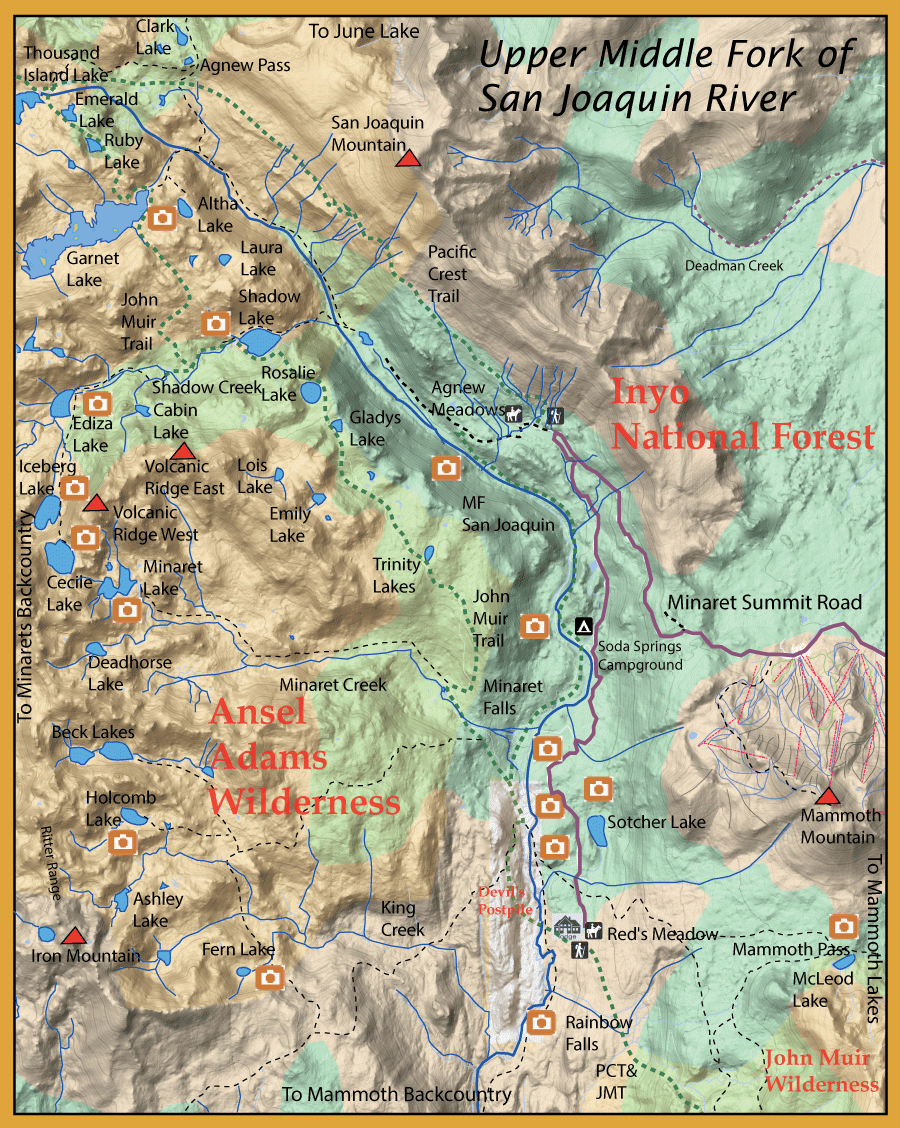
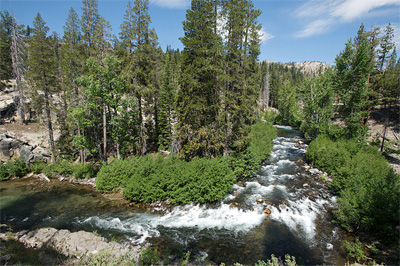
 The Upper MF of the San Joaquin drops over a 140′ lava ledge, called Rainbow Falls, creating a beautiful rainbow mist in the afternoon light. Below Rainbow Falls is a small section of water containing small falls and pools with rainbows in the 10-12 inch class. This section goes to a second Fall which then drops into a steep canyon with vertical cliffs that is inaccessible.
The Upper MF of the San Joaquin drops over a 140′ lava ledge, called Rainbow Falls, creating a beautiful rainbow mist in the afternoon light. Below Rainbow Falls is a small section of water containing small falls and pools with rainbows in the 10-12 inch class. This section goes to a second Fall which then drops into a steep canyon with vertical cliffs that is inaccessible.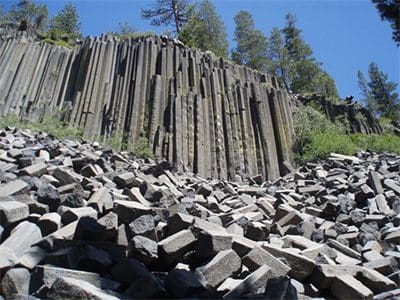
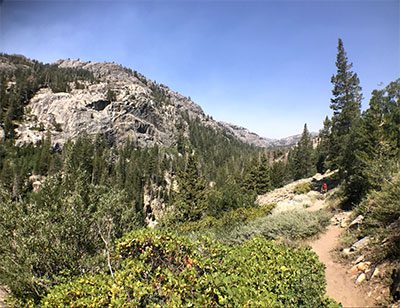 Shadow Lake: Elevation is 8800 feet. The 51 acre lake is 2.9 miles from the Trailhead. It is mostly a level trail with a 750 foot gain over the last mile to the lake. Contains Rainbows and Brookies.
Shadow Lake: Elevation is 8800 feet. The 51 acre lake is 2.9 miles from the Trailhead. It is mostly a level trail with a 750 foot gain over the last mile to the lake. Contains Rainbows and Brookies.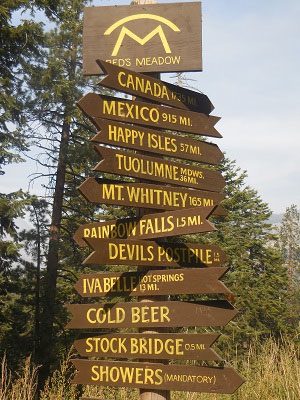 Minaret Creek: Elevation is 9800 feet. The creek can be fished above the Falls for about 4 miles up to Minaret Lake. Contains Rainbows and Brookies.
Minaret Creek: Elevation is 9800 feet. The creek can be fished above the Falls for about 4 miles up to Minaret Lake. Contains Rainbows and Brookies.